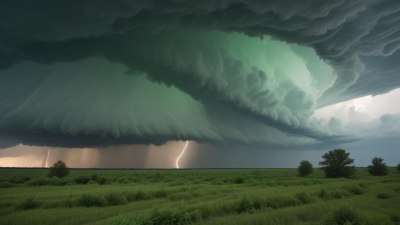How Weather Balloons Help Forecast Storms You Never See Coming
Discover the critical role weather balloons play in predicting unseen storms and enhancing weather forecasts.

Weather balloons have been an essential tool in meteorology for decades, playing a crucial role in how scientists understand and predict weather patterns. These large balloons, filled with helium or hydrogen, carry instruments that measure various atmospheric parameters. From temperature and humidity to wind speed and direction, these measurements are invaluable for forecasting storms, many of which might remain undetected without this data.
The use of weather balloons dates back to the late 19th century when scientists began exploring the atmosphere's behavior. These instruments can ascend to altitudes of up to 120,000 feet, providing a vertical profile of the atmosphere that ground-based measuring stations cannot achieve. The data they collect feeds directly into weather prediction models, transforming our ability to forecast dangerous weather events, including severe storms that often develop rapidly and unexpectedly.
The Anatomy of a Weather Balloon
A typical weather balloon consists of a latex or neoprene material that can stretch as it ascends through the atmosphere. At the balloon's base is a payload of meteorological instruments, including a radiosonde. This device collects and transmits data about temperature, pressure, and humidity back to ground stations. As the balloon rises, it expands due to the decreasing atmospheric pressure until it eventually bursts, typically at around 100,000 to 120,000 feet.
This release is not a failure; instead, it ensures that the instruments return to Earth safely, often with the help of a parachute. Each balloon release through a network of weather stations contributes to a collective understanding of the atmosphere, allowing meteorologists to create more accurate forecasts.
Data Collection and Distribution
The data obtained from weather balloons undergoes rigorous analysis before it's integrated into forecasting models. Meteorological agencies release these balloons twice daily from various locations worldwide, gathering data that covers a broad geographical area. This international collaboration is essential in a global climate where weather systems often cross borders.
Once the data is collected, it is transmitted to various meteorological organizations, including the National Weather Service in the United States, which then uses it to update forecasting models. Meteorologists analyze this data in conjunction with other tools, such as satellites and Doppler radar, to gain a comprehensive view of developing weather systems. The real-time data provided by weather balloons allows forecasters to make timely and informed decisions about potential storm threats.
Predictive Power of Weather Balloons
One of the significant advantages of weather balloons is their ability to detect changes in atmospheric conditions that may signal developing storms. For instance, if a balloon measures an unexpected drop in pressure coupled with increasing humidity at a certain altitude, this can indicate that a storm is forming. Furthermore, the data collected can reveal wind shear, a phenomenon that can lead to more severe storm systems, including tornadoes.
The ability of weather balloons to provide vertical profiles of the atmosphere enhances meteorologists' understanding of the relationship between different weather layers. These profiles can indicate whether conditions are ripe for the development of severe thunderstorms or even hurricanes. By forecasting these storms accurately, emergency services can prepare better, and officials can issue timely warnings to the public.
Limitations and Challenges
Additionally, weather balloons only provide a snapshot of atmospheric conditions as they ascend. Since a balloon's journey lasts only a few hours, changes in the atmosphere can occur after data is collected. While sophisticated forecasting models use historical data to account for this, discrepancies can still arise, leading to less accurate predictions for fast-developing storm situations.
Future of Weather Balloon Technology
Advancements in technology are paving the way for improvements in weather balloon systems. Newer balloons are created with more durable materials to withstand harsher conditions and provide longer flights. Innovations in instrument technology are also contributing to more accurate and higher resolution data, allowing scientists to capture more nuanced changes in atmospheric conditions.
Additionally, wireless technology is making it easier for weather balloons to communicate their data in real time. This immediate feedback means that meteorologists can make quicker decisions when monitoring storm development. There is also ongoing research into integrating data from weather balloons with information from drones and other aerial systems, potentially enhancing the precision of weather forecasting even further.
Real-World Impact of Weather Balloon Data
The real-world implications of accurate weather forecasting can't be understated. For instance, when severe storms develop, timely forecasts can save lives. In areas prone to hurricanes, the data collected from weather balloons can inform evacuation orders and preparedness measures, significantly reducing the risks to vulnerable populations.
Additionally, the agricultural sector benefits immensely from advancements in weather forecasting. Farmers rely on accurate weather data to plan their planting and harvesting schedules. By using refined forecasts that incorporate weather balloon data, they can make more informed decisions, thus optimizing yield and reducing losses due to unexpected weather events.
Weather balloons are an unsung hero in the world of meteorology, offering critical insights into atmospheric conditions that would otherwise go unnoticed. As technology advances, their role in storm forecasting is set to become even more significant, helping to protect communities and enhance our understanding of weather phenomena. While challenges remain, the ongoing integration of weather balloon data into predictive models promises to improve the accuracy of weather forecasting, ensuring that the storms you never see coming are forecasted more effectively.











